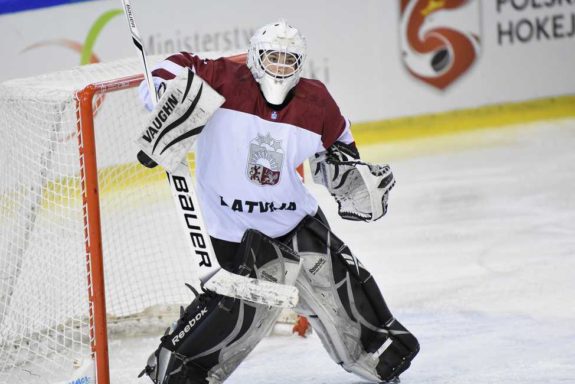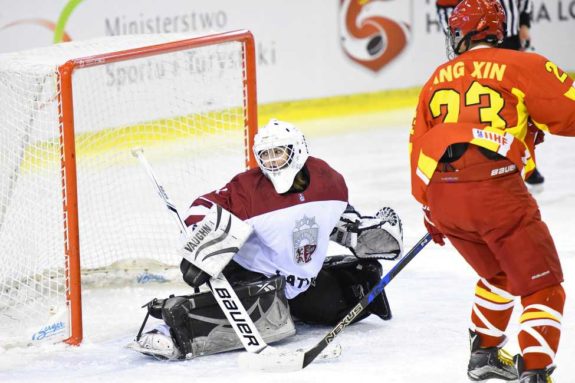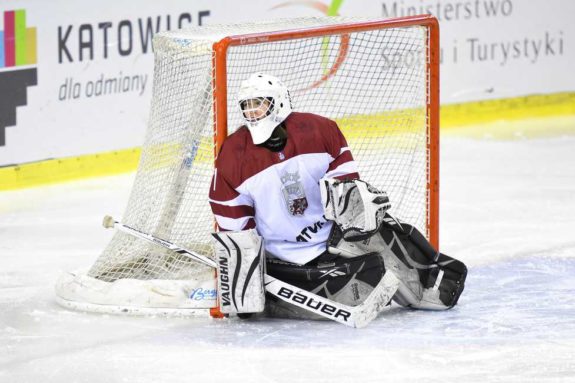Commonplace as it might be in backyards and recreational centers for a parent to play with their child in sport, it does not occur in high-level competition. Seemingly once in a million, if that. In fact, this may be the rarest of occasions in any sport. When it comes to hockey, Gordie Howe had the chance to play alongside two of his sons, Mark and Marty. There can’t be too many other instances besides that one in the NHL.
But, what about a daughter who plays with her sister and her mother? Not only that, but they have represented their country in multiple international competitions. This may be the rarest case of all.
But it is the case for Latvian women’s national team goaltender Kristiāna Apsīte. At just 17 years of age, Apsīte has played for Latvia with 43-year-old mother Aija and her 19-year-old sister Agnese. Aija has represented her homeland in international play since the early 2000s.

Asked what having hockey be a family affair means to her, Kristiāna responded:
“It doesn’t mean much to me because on the ice we are just teammates to each other just like everybody else. Of course, it is nice to play with my mom and my sister, but at the game, none of us think who is family or who is friend because the team is also like family.”
Well stated. THW had a chance to talk with Apsīte and find out more about this up-and-coming young goalie.
The Latvian Game and Early Beginnings
Latvia has produced numerous successful male players. Going back to some of the great Soviet teams of the 1970s, there was Helmut Balderis. He would make the jump at age 37 to the NHL with the Minnesota North Stars. That paved the way for stars such as Sandis Ozolinsh (the first Latvian to win the Stanley Cup), Arturs Irbe, the late Sergei Zholtok, and the late Karlis Skrastins. Today Buffalo Sabres forward Zemgus Girgensons represents his country in the NHL, and garnered enough of a following in his homeland to be voted into an NHL All-Star Game.
But much less is known about the Latvian women’s game. Opportunities for a young female goaltender like Apsīte are quite limited in her homeland.
“In Latvia, women’s hockey level is not as high as in North America or some bigger European countries,” Apsīte explained. “We only have three teams in the Latvian championship. So that’s why I am also practicing with boys teams since I started to play hockey.”

Apsīte’s sister Agnese has made the jump to the United States and plays NCAA Division III hockey for the Wisconsin-Superior Yellowjackets. Apsīte herself considers the thought of playing collegiate hockey or in Europe.
“Yes, it’s her (Agnese) first season playing college hockey in the USA. Of course, I’d like to play college hockey in the USA or play in Europe.”
Getting to Know Apsīte
Apsīte hails from Dreilini, a more recently built neighborhood on the eastern edge of the capital city of Riga, Latvia. Balderis, Ozolinsh, and Girgensons all come from Riga. Close to 640,000 people live in this largest city of the Baltic states. Apsīte began playing hockey at the age of four but did not take up the goaltending position until age 10.
“This is my 8th season as a goalie and I have never thought about changing back to a player position,” she shared. “I started to play in the goalie position when I was 10. My coach Lolita Andrisevska asked me if I wanted to try how it is to be a goalie. So in the next practice, I was wearing goalie equipment. After that practice, I realized how cool it is to make saves so I decided to become a goalie.”
With great goalies comes great results, Latvia is on the rise. Watch out for Kristiāna Apsīte! #ZeroHero 🌟🇱🇻 pic.twitter.com/0cws6DBmwp
— Mats Bekkevold (@Smats1984) June 12, 2017
Apsīte’s learning from the finest. Andrisevska has been the premier women’s goaltender in Latvia since at least the 1990s. Though she has served in a coaching role since 2012, she represented the nation in multiple women’s world championships and Olympic qualifiers for over a decade. In the 2009 Women’s Division II World Championship, Andrisevska backstopped Latvia to a gold medal. The team went undefeated, and she allowed only two goals in five games for a 0.50 goals-against average and a .984 save percentage. Apsīte has a superb teacher, to say the least.
“I didn’t have a hockey hero while I was growing up,” she stated. “But I enjoyed watching how Lolita Andrisevska played and made amazing saves because she was my coach and she was the one who taught me all the basic things when I became a goalie.”
A Student of the Position
And much like Andrisevska, Apsīte is a student of the goaltending position. This is particularly impressive considering her young age, but highly integral to her development. It is why she is well on her way to becoming one of the top young goaltenders in the world. She has not even approached her prime—that is still some years away.
“Being a goalie is not as easy as many players might think”, said Apsīte. “As a goalie, you need to be strong physically and also mentally. Every situation and shot is different so you never know where the shot is coming from, or if maybe there will be a pass to another player. Goalies don’t have a specific system like players do—we have our own style, and every goalie has a little bit different technique. Of course, there are some basics that are the same for every goalie, but as you develop over the years you find your own style. That’s why I didn’t quit the goalie position. There won’t be two exact same games or situations. I need to think really fast what I am going to do in each situation to make a save and win the game.”
Thus far, Apsīte has done quite well at that and she will only get better. 17 is a tender young age for any athlete. There is plenty more development to take place.
Major Accomplishments at a Young Age
For the past two years, Apsīte has won a silver and a bronze medal at Women’s Division I-B World Championships. The 2016 silver coming in Asiago, Italy, while the 2017 bronze was won in Katowice, Poland.
For the silver medal, Apsīte got into one game against the Netherlands while teammate Evija Tētiņa got the action for the other games. Still, it was Apsīte’s first World Championship and she was all of 15 years old. She stopped 28 of 32 shots in the loss to the Netherlands.
In 2017, Apsīte would get the nod as the starting goaltender for Latvia and she played in all five tournament games. Her finest performance in that tournament was likely against Italy in Latvia’s first game – Apsīte stopped 52 out of 53 shots she faced. In five games, she made a whopping 156 saves and finished with a .902 save percentage as Latvia took home the bronze.
https://youtu.be/sF0XO6hOreU
These were just the first two of what is bound to be many more international tournaments for Apsīte.
“Those medals mean a lot to me and they are very important because I know that hard work has paid off,” she shared. “I am happy that I had a chance to already play in my first year with the national team while I am still young because that was my goal ever since I started to play hockey. I hope we will earn gold in the World Championship (this year), and next year play in Division 1-A with the Latvian national team.”
The 2018 tournament for Division 1-B will once again be in Asiago, Italy in April. If Apsīte and Latvia can win the gold medal there, they will be promoted into group A.
Apsīte’s Finest Assets as a Goalie
Apsīte has a long career ahead of her, especially if she intends to play hockey as long as her mother has (and continues to). Obviously, at just 17 years of age (Apsīte will not turn 18 until May 2018) she has more time ahead to hone her skills. Regardless, this young lady already possesses a keen understanding of her own best attributes and how she can grow as a netminder.
“When I started to play hockey, at first I was a player and that helped me a lot especially with my skating,” Apsīte explained. “Good skating helps me to improve my goalie technique even faster. Characteristics and mental toughness is something that I am still trying to improve. One of them is to be patient, because I am a short goalie and it’s important to stay on my feet as long as possible. But the most important is to be self-confident. I can’t show my team or opponents that I’m not sure or I’m scared about what I am doing. After a goal I need to stay positive and mentally strong and continuously play like the score is still 0-0. Also I think that it is really important for a goalie to be calm because only when you are calm you can make the best decisions in every situation. These are the things that I still need to improve every game and practice.”
Much like the diminutive Arturs Irbe, who was all of 5-foot-8 when he played, Apsīte is only five feet tall. But, like Irbe, she is quick as lightning and has highly impressive reflexes.
What She Has Learned From Mom
Apsīte’s mother Aija has represented Latvia in close to 80 international games. That includes Olympic qualifiers and World Championships at various levels. Aija is a staple of Latvian women’s hockey. It would stand to reason that she has passed some of her knowledge down to her goaltending daughter.
“I think that the most important thing that my mom has taught me is to never give up,” said Apsīte. “As long as you never give up and try your best every time ’til the final second of the game, it’s not important what the result is. You need to play and show your best every time when your are on the ice. For me as a goalie it means that I need to play until the last second of the game. Situations in front of my net end only when the puck is in my glove or in the net; hopefully not too many times. A goalie’s job is to try to save every puck even if it seems impossible. If you don’t try you never know if you could have made that save or not.”

The way that she studies the position and looks at the philosophical portions of it, Apsīte sounds like a young, female Jacques Plante. Certainly some excellent advice from her mom as well.
What Dreams May Come
Like many women’s national teams throughout the globe, Latvia is striving for the next level. Unlike the men’s tournament which includes 12 teams, the women’s hockey portion of the 2018 PyeongChang Winter Games has only eight teams competing. That includes the host nation of South Korea, as well Switzerland and Japan that both qualified. The powerhouse teams of the United States, Canada, Russia, Finland, and Sweden established themselves through the IIHF’s world rankings through five prior tournaments (including the 2014 Sochi Olympics, and the World Championships from 2013 up to and including 2016).
It is one of those qualification spots that Switzerland and Japan captured that Apsīte and Latvia are aiming towards. Similar caliber teams such as Kazakhstan’s and Slovakia’s women’s teams have qualified for the Olympics before. This is what hockey for Apsīte and her family is really all about. Aija Apsīte has played in four different Olympic qualifying tournaments for Latvia and sets the example for her daughters. But that family aspect is extended to not just mother and daughters, but for the family comprised by all of their Latvian teammates.
Exhibition about 80 years of Latvian hockey history at the WW Div. IA in Ventspils, including a women's hockey part. pic.twitter.com/y1JBoGQp
— IIHF (@IIHFHockey) March 30, 2012
“My biggest hockey dream is to qualify and play in the Winter Olympics with the Latvian national team,” Apsīte stated confidently.
Stick to that motto that your mom instilled in you, Kristiāna. The talent and desire are within you to make your dream come true.